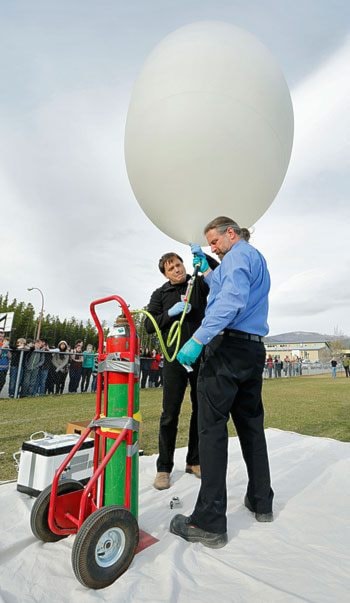Students and staff at Porter Creek Secondary School are taking science to new heights these days - about 80,000 feet, to be exact.
On April 28, they launched a high-altitude weather balloon outfitted with a small payload weighing 1,200 grams.
Inside the tightly sealed Styrofoam box was a GoPro camera, an Arduino computer and a stuffed ram, the school’s mascot.
The small computer, about the size of a chocolate bar, was hooked up to electronic sensors on the outside of the box, which measured everything from atmospheric pressure to oxygen levels.
Arduino is an open-source platform and community that designs easy-to-use hardware and software for people who want to make interactive projects.
For example, you could use an Arduino board to activate a system that would water your plants at home when it receives a message from Twitter.
In this case, the computer was assembled and programmed by students at the University of Regina and sent to the Porter Creek school for free.
The project was part of the Canada-wide High Altitude Balloon Experiment sponsored by the university.
A tiny memory card inside the computer captured the data as the balloon rose higher and higher into the Earth’s atmosphere.
Roger Gillies and Dave Brown, both teachers at the school, learned the ropes to find out how to send the balloon into space.
The data collected on the card will be sent back to the university for analysis.
But they will also be used at Porter Creek, Brown said.
The Grade 8 students will use them to learn about atmospheric pressure, buoyancy and density. The Grade 9 students will use the GPS data in their space program, while the Grade 10 students will analyze acceleration and speed data in their physics class.
“It’s a cool opportunity for students to get involved in something that, maybe a decade ago, would have only been the realm of real scientists,” Gillies said.
Figuring out how to launch the balloon was relatively simple. Brown and Gillies used online calculators to determine how much helium to put inside.
Filling it up with too much helium would mean it would rise faster but burst earlier, because of the pressure at higher altitudes.
So they settled on 1,500 grams of buoyancy and a 1,200-gram payload, which meant the balloon would rise at about six metres per second.
Figuring out where the balloon would land, however, was trickier.
Once it reached 60,000 feet, the GPS device stopped sending data.
It turns out there is a limit placed on GPS devices that disables tracking when the device calculates it is moving faster than 1,900 kilometres per hour or traveling at an altitude higher than 60,000 feet.
This was intended to prevent the use of GPS in intercontinental ballistic missile-like applications.
“We knew it had achieved that height but we were worried we’d done something wrong and it had burst earlier,” Brown said.
Luckily, the pair had a good idea of where the balloon might land.
They entered data such as helium levels, Whitehorse’s altitude above sea level and the weight of the payload into an online calculator programmed by the University of Cambridge.
The tool crunched the numbers in addition to analyzing the local weather forecast to determine an approximate spot where it thought the package would land.
“It was unbelievably accurate,” Gillies said.
“Probably within a few kilometres of where it actually landed.”
The balloon popped at around 80,000 feet, they think, based on the computer’s data.
It landed 122 kilometres away from Whitehorse, about six nautical miles past the north end of Lake Laberge in a swampy area.
A Capital Helicopters pilot took Brown and Gillies out to the site, where they found it sitting in a tree.
When Gillies took the camera home and looked at the footage, he was floored, he said.
“The first thing I saw was the shot from 12 kilometres up, the curvature of the earth and the blackness of space,” he said.
“Then I started scrubbing through the footage to find the spot where it popped and started falling back to earth again. Next year we’re talking about maybe sending it up early in the morning so that it’s dark and it can rise in the light.”
The entire experiment can be assembled for about $300 to $400, they said.
“Thinking you can participate in a scientific experiment for that little money is pretty exciting,” Gillies said.
Participation is one thing, but preparation is another.
The pair came close to sabotaging the project themselves when they realized, just seconds before launch, that they hadn’t turned anything on inside the box.
Contact Myles Dolphin at
myles@yukon-news.com
